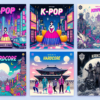Perubahan genre drama Korea selama dekade terlihat melalui eksplorasi tema yang lebih beragam dan penggabungan elemen genre lainnya.
Transformasi Genre Drama Korea Selama Dekade
-
Table of Contents
- Introduction
- The Rise of Korean Dramas in Indonesia
- Early Influence
- Streaming Platforms and Accessibility
- Quality Production and Storytelling
- Evolution of Korean Drama Genres
- Romantic Comedies
- Thrillers and Crime Dramas
- Fantasy and Supernatural
- Impact on Indonesian Viewers
- Cultural Exchange
- Emotional Connection
- Escapism and Entertainment
- Conclusion
Introduction

The Korean drama industry has experienced a significant transformation over the past decade, captivating audiences not only in Korea but also around the world. In Indonesia, the popularity of Korean dramas, also known as K-dramas, has skyrocketed, leading to a surge in demand for this genre. This article will explore the evolution of Korean dramas in Indonesia over the past decade, highlighting the key factors that have contributed to their success and examining the impact they have had on Indonesian viewers.
The Rise of Korean Dramas in Indonesia
Early Influence
The first Korean dramas to make their way to Indonesian television screens were primarily historical dramas, known as sageuks. These sageuks gained popularity due to their unique storytelling and cultural elements, which resonated with Indonesian viewers. The success of these early dramas laid the foundation for the subsequent rise of Korean dramas in the country.
Streaming Platforms and Accessibility
The advent of streaming platforms, such as Netflix and Viu, played a crucial role in the widespread popularity of Korean dramas in Indonesia. These platforms made it easier for Indonesian viewers to access a wide range of Korean dramas, with subtitles available in their native language. The convenience and affordability of these platforms allowed viewers to binge-watch their favorite dramas, further fueling the demand for Korean content.
Quality Production and Storytelling
Korean dramas are known for their high production values and compelling storytelling. The industry’s commitment to delivering quality content has been a significant factor in attracting Indonesian viewers. The intricate plotlines, well-developed characters, and emotional depth of Korean dramas have resonated with Indonesian audiences, who appreciate the attention to detail and the ability of these dramas to evoke a wide range of emotions.
Evolution of Korean Drama Genres
Romantic Comedies
Romantic comedies, or rom-coms, have always been a popular genre in Korean dramas. However, over the past decade, there has been a noticeable shift in the portrayal of romance in these dramas. While traditional rom-coms focused on light-hearted and predictable storylines, recent dramas have embraced more complex and realistic portrayals of relationships. This evolution has allowed Indonesian viewers to connect with the characters on a deeper level and has made the genre more relatable and engaging.
Thrillers and Crime Dramas
Another genre that has gained traction in the Indonesian market is thrillers and crime dramas. These dramas often feature intricate plotlines, suspenseful storytelling, and intense character development. The success of dramas like “Signal” and “Stranger” has demonstrated the growing appetite for this genre among Indonesian viewers. The popularity of thrillers and crime dramas can be attributed to their ability to keep viewers on the edge of their seats and provide a refreshing break from the more traditional romance-focused dramas.
Fantasy and Supernatural
In recent years, Korean dramas with fantasy and supernatural elements have become increasingly popular in Indonesia. Dramas like “Guardian: The Lonely and Great God” and “Hotel Del Luna” have captivated Indonesian viewers with their imaginative storytelling and visually stunning production. The inclusion of fantasy elements allows these dramas to explore unique themes and create a sense of escapism for viewers. The success of this genre highlights the growing diversity of Korean dramas and their ability to cater to a wide range of preferences.
Impact on Indonesian Viewers
The rise of Korean dramas in Indonesia has had a profound impact on Indonesian viewers, both culturally and socially.
Cultural Exchange
Korean dramas have played a significant role in fostering cultural exchange between Korea and Indonesia. Through these dramas, Indonesian viewers have been exposed to Korean traditions, customs, and language. This exposure has sparked an interest in Korean culture, leading to an increase in the popularity of K-pop music, Korean cuisine, and even tourism to Korea. The cultural exchange facilitated by Korean dramas has created a bridge between the two countries, fostering a deeper understanding and appreciation of each other’s cultures.
Emotional Connection
One of the key reasons for the popularity of Korean dramas in Indonesia is the emotional connection they create with viewers. Indonesian audiences have been drawn to the relatable characters, heartfelt storylines, and the ability of these dramas to evoke a wide range of emotions. The emotional impact of Korean dramas has led to a strong fan culture in Indonesia, with fan clubs, fan events, and online communities dedicated to discussing and sharing their love for Korean dramas. This sense of community and shared passion has further strengthened the bond between Indonesian viewers and Korean dramas.
Escapism and Entertainment
Korean dramas provide a form of escapism for Indonesian viewers, allowing them to immerse themselves in captivating storylines and beautiful cinematography. The dramas offer a temporary escape from the realities of everyday life and provide a source of entertainment and relaxation. The addictive nature of Korean dramas, coupled with their ability to transport viewers to different worlds, has made them a popular choice for Indonesian audiences seeking a break from their daily routines.
Conclusion
The transformation of Korean dramas in Indonesia over the past decade has been remarkable. From their humble beginnings as historical sageuks to the diverse range of genres available today, Korean dramas have captured the hearts of Indonesian viewers. The rise of streaming platforms, the commitment to quality production, and the evolution of storytelling have all contributed to the success of Korean dramas in Indonesia. The impact of these dramas on Indonesian viewers is evident in the cultural exchange, emotional connection, and sense of escapism they provide. As the popularity of Korean dramas continues to grow, it is clear that they have become an integral part of Indonesian entertainment culture.







